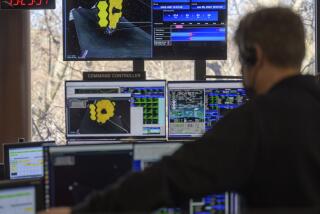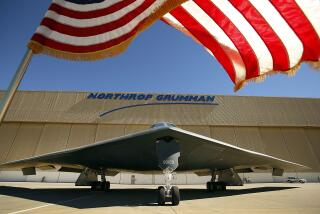68-year aviation career touches down
- Share via
When Jerry Huben began working for Northrop Aircraft Co. in 1941, the starting pay for a factory worker was 65 cents an hour and engineers armed with slide rules designed airplanes on a drafting board.
On Tuesday, Huben’s co-workers at what is now Northrop Grumman Corp. in El Segundo held a send-off for the aircraft engineer, who was retiring after 68 years of helping build some of the nation’s more notable airplanes.
No one else had worked as long. No one had even come close.
“It’s truly remarkable,” said Scott Sommer, a Northrop business manager in El Segundo who hosted the retirement party at the Proud Bird, an eatery at the eastern end of the runway at Los Angeles International Airport that is also part of the region’s aviation lore.
The restaurant, which is part aviation museum with airplanes from the region’s heyday on display around its grounds, was an ideal setting to honor Huben -- a living aviation history book. Huben’s nearly seven-decade career spanned the evolution of aviation from planes driven by propellers to the slick, radar-evading stealthy jets of today.
Huben, 88, was involved in the design, development and building of 18 different aircraft, including the first XB-35 flying wing and the first U.S. jet fighter as well as the modern F/A-18 fighter aircraft and the B-2 stealth bomber.
He also worked alongside Jack Northrop, the legendary aircraft maker and namesake for what is now the nation’s second-largest defense contractor. Northrop, who died in 1981, formed the company in 1939, two years before Huben became an employee.
“It seems like yesterday I was working with Jack,” Huben said, recalling how Northrop liked to wander around the Hawthorne shop at night after most people had gone home. “He liked to talk to people then and see how things were going.”
The tribute and a recap of Huben’s career also provided a comic look back at the region’s heritage. A TV commercial from the 1950s promoted moving to Southern California by noting that new homes here were the “least expensive in all of the U.S.”
An ad from the 1960s featured a slinky female model in tight shorts showing off a Northrop T-38 military trainer aircraft as though she were selling a sports car.
Huben, who may also be the longest-living resident of Westchester with 60 years in the same house, began working for Northrop just three weeks before Japan attacked Pearl Harbor in Hawaii on Dec. 7, 1941, sparking the U.S.’ entry into World War II.
He was 20 at the time and just out of a technical school in Glendale that was set up by Jack Northrop to train aircraft engineers. But no engineering jobs were available, so Huben began work as a riveter.
“I figured if I got into Northrop somehow, sooner or later I would get into engineering,” Huben said. “Three weeks later Pearl Harbor happened, and things really took off. Suddenly we changed from a nation that was semi-asleep to working 24 hours a day, seven days a week.”
The aviation industry in Southern California has slowed and dwindled considerably since then, a process that “didn’t seem like it was happening at the time,” Huben said. “But I guess in a 40-year period things went downhill quite a bit.”
Once the nation’s center for aircraft manufacturing, the region is now home to one final assembly line where Boeing Co. makes C-17 cargo planes in Long Beach.
Huben said he wasn’t planning to retire until a back injury sidelined him.
Sommer told the crowd that the company was prepared to release Huben from his 1941 employment agreement, which among other things required punctuality and working “60 minutes of every hour.”
It was time, Sommer said, for Huben to “go play.”
--
More to Read
Inside the business of entertainment
The Wide Shot brings you news, analysis and insights on everything from streaming wars to production — and what it all means for the future.
You may occasionally receive promotional content from the Los Angeles Times.










